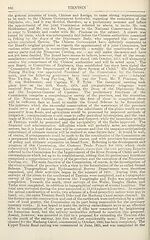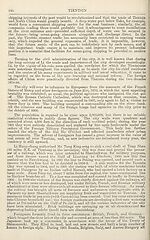1926
(645) Page 589
Download files
Complete book:
Individual page:
Thumbnail gallery: Grid view | List view

TIENTSIN
589
autumn of 1923. This cutting shortens the Haiho river by 6,000 feet and does
away with four bad bends. In May, 1922, at the request of the Board, the engineer-in¬
chief presented a report on the future of the Haiho and its approaches, advocating the
adoption of important further improvement measures, particularly in regard to the
Taku Bar Channel. The Board decided, in addition to consulting the former chief
engineer, Mr. de Linde, to obtain further expert opinion on the proposals before taking
action on them. Mr. Louis Perrier was accordingly iiivited to come to Tientsin to
study the subject and give his opinion. Mr. Perrier supports entirely the engineer-in¬
chief’s proposals and is confident that in the not distant future it will be possible, if
those proposals are adopted, for vessels with a draught of 26 feet to come to Tangku
and for vessels with a draught of 20 feet to come do Tientsin Bund. lib is satisfactory
to record that in 1920 the financial position of the Commission was considerably im¬
proved by the guarantee of a monthly grant of Tls. 30,000, which is sufficient to cover
the ordinary recurring expenditure.
Mention was made in the report of the Commissioner of Customs for 1920 of the
, Peiho reversion scheme and of the advisability of concentrating energies and resources
on the diversion of the Yungtingho. A scheme for the latter was worked out at an
estimated cost of $17,500,000, to which a further sum, varying from $2,000,000
to $10,000,000, may have to be added if it is finally decided to construct a
' protective sea-dike to prevent deterioration of the Haiho channel;1 regarding the
necessity of which opinions are divided. At meetings which took place in July and
August, 1921, the members of the Commission came to the conclusion that in the
present financial state of China it would be impossible to procure the funds
necessary to finance either the total Peiho reversion or Yungtingho diversion
schemes, both of which they considered were essential for a radical solution of
improvement of the system of the rivers in the northern portion of the province.
They, therefore, decided to recommend a scheme for the partial reversion of the
■ Peiho, estimated to cost $2,500,000, of which the Commission had in hand
about $2,250,000, as this would ensure fulfilment of all the conditions requir¬
ed by the Haiho Conservancy Board and would materially improve the
navigation for boat traffic between Tientsin and Tungchow. It was recognised,
however, that the flooding of the Paotihsien and adjoining districts would not be
fully provided against, although the effect of floods would be reduced by the
amount of water drawn off by the Peiho. The Chinese Government has been
.approached by the President of the Commission for sanction to carry out the
partial diversion scheme, which, it now seems probable, will be taken in hand at an
early date. Thanks to the efforts of Admiral Woo Yu Ling in his capacity as Director-
General Of River Affairs of the Eastern Metropolitan Area, over 80 per cent, of the
land required for the excavation of a channel for reverting the supply has been acquired.
Tenders have been called for and received for the construction of the new
International Bridge from the continuation of Rue de France, in the French
Concession, to Laptiev Road, in the Russian Concession.
_ Before closing these remarks upon the conservancy interests of Tientsin, it is
fitting to refer to a very important scheme brought forward by Mr. Maze,
the Commissioner of Customs there, viz., his proposal to establish a deep¬
water port at the river entrance below the town of Taku. The construction
of certain training works by the Haiho Conservancy Board in the vicinity for
the purpose of preventing further encroachment on the fairway of the North
Bank, and of maintaining the new line of direction of the Bar Channel, seemed
to him a favourable opportunity for suggesting that reclamation works to the
north of the training works should be undertaken in order to secure sufficient
ground for the construction of steamer-wharves, godowns, coal-yards and railway-
sidings on land reclaimed between the North Fort and the inner end of the
Deep Hole. The Engineer-in-Chief of the Haiho Conservancy Board advises
that from an engineering standpoint the scheme is quite feasible and would not
be unduly expensive, and that the position concerned—situated, as it is, at the
-actual mouth of the river—is, for a variety of reasons, the most suitable site avail¬
able. The first reach of the river is straight, is about 1,000 feet broad, and is
-deep, thus possessing obvious advantages for the accommodation ©f shipping. It is
superior in this and every other respect to sites a little further up stream, which
.are not only much more limited in extent but do not possess such favourable advan¬
tages as regards breadth of river or depth Of water. If facilities for deeper draught
.steamers are provided on the above lines, it is no exaggeration to state that the
589
autumn of 1923. This cutting shortens the Haiho river by 6,000 feet and does
away with four bad bends. In May, 1922, at the request of the Board, the engineer-in¬
chief presented a report on the future of the Haiho and its approaches, advocating the
adoption of important further improvement measures, particularly in regard to the
Taku Bar Channel. The Board decided, in addition to consulting the former chief
engineer, Mr. de Linde, to obtain further expert opinion on the proposals before taking
action on them. Mr. Louis Perrier was accordingly iiivited to come to Tientsin to
study the subject and give his opinion. Mr. Perrier supports entirely the engineer-in¬
chief’s proposals and is confident that in the not distant future it will be possible, if
those proposals are adopted, for vessels with a draught of 26 feet to come to Tangku
and for vessels with a draught of 20 feet to come do Tientsin Bund. lib is satisfactory
to record that in 1920 the financial position of the Commission was considerably im¬
proved by the guarantee of a monthly grant of Tls. 30,000, which is sufficient to cover
the ordinary recurring expenditure.
Mention was made in the report of the Commissioner of Customs for 1920 of the
, Peiho reversion scheme and of the advisability of concentrating energies and resources
on the diversion of the Yungtingho. A scheme for the latter was worked out at an
estimated cost of $17,500,000, to which a further sum, varying from $2,000,000
to $10,000,000, may have to be added if it is finally decided to construct a
' protective sea-dike to prevent deterioration of the Haiho channel;1 regarding the
necessity of which opinions are divided. At meetings which took place in July and
August, 1921, the members of the Commission came to the conclusion that in the
present financial state of China it would be impossible to procure the funds
necessary to finance either the total Peiho reversion or Yungtingho diversion
schemes, both of which they considered were essential for a radical solution of
improvement of the system of the rivers in the northern portion of the province.
They, therefore, decided to recommend a scheme for the partial reversion of the
■ Peiho, estimated to cost $2,500,000, of which the Commission had in hand
about $2,250,000, as this would ensure fulfilment of all the conditions requir¬
ed by the Haiho Conservancy Board and would materially improve the
navigation for boat traffic between Tientsin and Tungchow. It was recognised,
however, that the flooding of the Paotihsien and adjoining districts would not be
fully provided against, although the effect of floods would be reduced by the
amount of water drawn off by the Peiho. The Chinese Government has been
.approached by the President of the Commission for sanction to carry out the
partial diversion scheme, which, it now seems probable, will be taken in hand at an
early date. Thanks to the efforts of Admiral Woo Yu Ling in his capacity as Director-
General Of River Affairs of the Eastern Metropolitan Area, over 80 per cent, of the
land required for the excavation of a channel for reverting the supply has been acquired.
Tenders have been called for and received for the construction of the new
International Bridge from the continuation of Rue de France, in the French
Concession, to Laptiev Road, in the Russian Concession.
_ Before closing these remarks upon the conservancy interests of Tientsin, it is
fitting to refer to a very important scheme brought forward by Mr. Maze,
the Commissioner of Customs there, viz., his proposal to establish a deep¬
water port at the river entrance below the town of Taku. The construction
of certain training works by the Haiho Conservancy Board in the vicinity for
the purpose of preventing further encroachment on the fairway of the North
Bank, and of maintaining the new line of direction of the Bar Channel, seemed
to him a favourable opportunity for suggesting that reclamation works to the
north of the training works should be undertaken in order to secure sufficient
ground for the construction of steamer-wharves, godowns, coal-yards and railway-
sidings on land reclaimed between the North Fort and the inner end of the
Deep Hole. The Engineer-in-Chief of the Haiho Conservancy Board advises
that from an engineering standpoint the scheme is quite feasible and would not
be unduly expensive, and that the position concerned—situated, as it is, at the
-actual mouth of the river—is, for a variety of reasons, the most suitable site avail¬
able. The first reach of the river is straight, is about 1,000 feet broad, and is
-deep, thus possessing obvious advantages for the accommodation ©f shipping. It is
superior in this and every other respect to sites a little further up stream, which
.are not only much more limited in extent but do not possess such favourable advan¬
tages as regards breadth of river or depth Of water. If facilities for deeper draught
.steamers are provided on the above lines, it is no exaggeration to state that the
Set display mode to:
![]() Universal Viewer |
Universal Viewer | ![]() Mirador |
Large image | Transcription
Mirador |
Large image | Transcription
Images and transcriptions on this page, including medium image downloads, may be used under the Creative Commons Attribution 4.0 International Licence unless otherwise stated. ![]()
| Asian directories and chronicles > 1926 > (645) Page 589 |
|---|
| Permanent URL | https://digital.nls.uk/196496558 |
|---|
| Attribution and copyright: |
|
|---|---|
| Description | Volumes from the Asian 'Directory and Chronicle' series covering 1917-1941, but missing 1919 and 1923. Compiled annually from a multiplicity of local sources and research. They provide listings of each country's active corporations, foreign residents and government agencies of all nationalities for that year, together with their addresses. Content includes: various treaties; coverage of conflicts; currencies and taxes; consular fees; weights and measures; public holidays; festivals and traditions. A source of information for both Western states and communities of foreigners living in Asia. Published by Hongkong Daily Press. |
|---|---|
| Shelfmark | H3.86.1303 |
| Additional NLS resources: |

